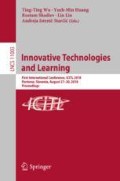Abstract
In this paper, an innovative simulated learning model to improve the efficiency of nursing skills training by the help of mixed reality technique is proposed and the nasogastric tube care is selected as our first training course example. An interactive self-training methodology containing step by step operation directions, as well as the on line test after the course is designed using mixed reality scenario and wearable device platforms. This method fulfills the strategy of learning by practice while reducing the related cost and effort significantly. From the implemented system, it is observed by some test samples feedback that the teaching auxiliary system can not only improves the student’s interest in skill training but enhances the learning performance than the traditional teaching methods, and can be applied in other skill training fields successfully.
Access this chapter
Tax calculation will be finalised at checkout
Purchases are for personal use only
References
Jeffries, P.R. (ed.): Simulation in Nursing Education: From Conceptualization to Evaluation. National league for Nursing, New York (2007)
Waxman, K.: The development of evidence-based clinical simulation scenarios: guidelines for nurse educators. J. Nurs. Educ. 49(1), 29–35 (2010). https://doi.org/10.3928/01484834-20090916-07
Landeen, L., Nielson, A.: Focus on simulation-integrating simulation into teaching practice. J. Nurs. Educ. 47(11), 487–488 (2008)
Handwerker, S.M.: Transforming nursing education: a review of current curricular practices in relation to Benner’s latest work. Int. J. Nurs. Educ. Scholarsh. 9(1) (2012). http://dx.doi.org/10.1515/1548-923X.2510, (Article 21)
Ahn, H., Kim, H.: Implementation and outcome evaluation of high-fidelity simulation scenarios to integrate cognitive and psychomotor skills for Korean nursing students. Nurse Educ. Today 35(5), 706–711 (2015)
Khalaila, R.: Simulation in nursing education: an evaluation of students’ outcomes at their first clinical practice combined with simulations. Nurse Educ. Today 34, 252–258 (2014). https://doi.org/10.1016/j.nedt.2013.08.015
Milgram, P., Kishino, A.F.: Taxonomy of mixed reality visual displays. In: IEICE Transactions on Information and Systems, pp. 1321–1329 (1994). Accessed 17 Oct 2013
Hettinger, L.J., Riccio, G.E., Visually induced motion sickness in virtual reality system: implications for training and mission rehearsal, In Interagency Conference on Visual Issues in Training and Simulation, Armstrong Laboratory, Aircrew Training Research Division, Williams Air Force Base, AZ (1991)
Shumaker, R., Lackey, S.: Virtual, augmented and mixed reality. designing and developing virtual and augmented environments. In: 6th International Conference Proceedings, Part I, Heraklion, Crete, Greece, 22–27 June (2014)
Hussein, M., Nätterdal, C.: The Benefits of Virtual Reality in Education-A Comparison Study, Bachelor Dissertation. Chalmers University of Technology, University of Gothenburg, Sweden (2015)
Freina, L., Ott, M.: A literature review on immersive virtual reality in education: state of the art and perspectives. In: Proceedings of eLearning and Software for Education (eLSE), Bucharest, 23–24 April (2015)
Zhu, E., Masiello, I., Hadadgar, A., Zary, N.: Augmented reality in healthcare education: an integrative review, PeerJ PrePrints, pp. 1–22 (2014)
Reinald, A.D.L., et al.: Augmented reality in nursing education: addressing the limitations of developing a learning material for nurses in the Philippines and Thailand. IJODeL, 2(1), (2016)
Carlson, K.J., Gagnon, D.J.: Augmented reality integrated simulation education in health care. Clin. Simul. Nurs. 12(4), 123–127 (2016)
Lai, C., Chu, Y.: Increasing the learning performance via augmented reality technology. In: Wu, T.-T., Gennari, R., Huang, Y.-M., Xie, H., Cao, Y. (eds.) SETE 2016. LNCS, vol. 10108, pp. 58–64. Springer, Cham (2017). https://doi.org/10.1007/978-3-319-52836-6_8
Karthika, S., Praveena, P., GokilaMani, M.: HOLOLENS. Int. J. Comput. Sci. Mobile Comput. 6(2), 41–50 (2017)
Lai, C.: An intuitive and interactive holographic instructional support system. Int. J. Electr. Electron. Data Commun. 5(9), 32–35 (2017)
van der Vlugt, N.: An ontological enquiry into the MagicLeap and Augmented Reality, Master thesis of Philosophy of Science Technology and Society in University of Twente, February 2017
Conn, M.A., Sharma, S., Immersive telerobotics using the oculus rift and the 5DT ultra data glove. In: 2016 International Conference on Collaboration Technologies and Systems, pp. 387–391, October 2016
Kiyokawa, K.: 3D collaboration using mixed reality technology. In: Proceedings of the First International Symposium on Universal Communication, pp. 100–109 (2007)
Krichenbauer, M., Yamamoto, G., Taketomi, T., Sandor, C., Kato, H.: Towards augmented reality user interfaces in 3D media production. In: proceedings of IEEE/ACM International Symposium on Mixed and Augmented Reality (ISMAR), Munich, Germany, pp. 23–28, September 2014
Author information
Authors and Affiliations
Corresponding author
Editor information
Editors and Affiliations
Rights and permissions
Copyright information
© 2018 Springer Nature Switzerland AG
About this paper
Cite this paper
Lai, C., Chang, Ym. (2018). Improving the Skills Training by Mixed Reality Simulation Learning. In: Wu, TT., Huang, YM., Shadiev, R., Lin, L., Starčič, A. (eds) Innovative Technologies and Learning. ICITL 2018. Lecture Notes in Computer Science(), vol 11003. Springer, Cham. https://doi.org/10.1007/978-3-319-99737-7_2
Download citation
DOI: https://doi.org/10.1007/978-3-319-99737-7_2
Published:
Publisher Name: Springer, Cham
Print ISBN: 978-3-319-99736-0
Online ISBN: 978-3-319-99737-7
eBook Packages: Computer ScienceComputer Science (R0)

